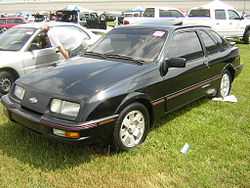Merkur
Merkur (German pronunciation: [mɛʁˈkuːɐ̯]), Mercury) was an automobile brand which was briefly marketed by Ford Motor Company in the United States and Canada from 1985 to 1989. The brand made only two entry-level luxury cars (as a smaller companion to Lincoln's large luxury cars).
 | |
| Industry | Automobile |
|---|---|
| Founded | 1985 |
| Defunct | 1989 |
| Headquarters | Dearborn, Michigan, USA |
| Products | Luxury cars |
| Parent | Ford Motor Company |
| Website | www.merkurclub.com (unofficial) |
Ford introduced the Merkur brand as a franchise separate from its other brands, and it was only offered to Lincoln-Mercury dealers, of which only about 800 accepted.
When the Merkur name was launched in North America, advertising and PR materials strongly urged the proper German pronunciation. Below the Merkur badge was a script stating FORD WERKE AG-Cologne, West Germany, indicating the car's place of manufacture.
Like the Capri before it, the Merkur was Ford's attempt at selling a European car in the North American market. However, Ford could not just import the cars and sell them; American government-mandated safety regulations dictated that Ford modify the design of the XR4Ti and Scorpio. This meant that the two cars were manufactured in Europe in a manner different from other European Fords. The XR4Ti was manufactured by Karmann in Rheine, Germany, with a turbocharged Ford Lima 2.3 L 4-cylinder engine from the Ford engine plant in Taubate, Brazil, and the Scorpio was manufactured in Ford's Cologne plant and fitted with the Cologne 2.9 L V6.
Only two models were sold under the Merkur badge: a performance-oriented three-door hatchback version of the Ford Sierra XR4i called the Merkur XR4Ti and nicknamed Merkur XR (1985–1989), and the Merkur Scorpio (1988–1989), which was an American version of the Ford Scorpio Mark I (Scorpio being the top trim level for the Mk III Granada in the UK) 5-door hatchback.
Neither model was particularly successful in Ford North America's eyes. Exchange rate fluctuations were one explanation. Also, the Scorpio bore a strong resemblance to the Mercury Topaz, and the similarly sized Mercury Sable, which were sold on the same showroom floors and were considerably cheaper.
Merkur Scorpios are well known for being nearly identical to each other in appearance and options. All of them had standard features, such as Automatic Climate Control, and the optional Touring Package upgrade was included with nearly every Merkur Scorpio sold. The original cost of a Merkur Scorpio was nearly US$30,000. A major factor in the decision to drop the cars was the US government's requirement to add either a passive restraint system or air bags for US models since these were not requirements for European models.[citation needed] The XR4Ti was dropped first and the Scorpio a few months later in 1989.
Merkur eventually joined Packard and Chrysler's Imperial in the fray of defunct luxury automotive brands. In addition, Merkur was also one of the shortest-lived luxury automotive marques.[citation needed]
Contrast to Ford of Europe
The Sierra was introduced as a replacement for the aging Ford Cortina/Ford Taunus, which was a bold move at the time considering that the Cortina/Taunus was one of Ford's best-selling cars. Despite Ford's initial misgivings about the styling, Sierra went on to be the second best-selling car in Europe [citation needed], second only to Ford's own Escort.
European Sierras were available in 3-door hatchback, 5-door hatchback, 4-door sedans, 5-door station wagons, and even a pickup truck called the P100. Engines were available from a 1.3-litre 60 hp 4-cylinder, to a 160 hp 2.8-litre V6, or a 2-litre, 16-valve, turbocharged and intercooled 4-cylinder as fitted to the Sierra Cosworth. According to British government test figures, fuel efficient models such as the 1.6 Economy could do 51 mpg-imp (5.5 L/100 km; 42 mpg-US) at a steady 56 mph (90 km/h), and 30 mpg-imp (9.4 L/100 km; 25 mpg-US) simulated urban driving.
At the other end of the spectrum the Sierra Cosworth would do 0-60 mph in 6.2 seconds and go on to a top speed of almost 150 mph (240 km/h) (and still be capable of over 20 mpg-imp (14 L/100 km; 17 mpg-US) if driven gently). Oddly, the Sierra XR range and the Cosworth models are not viewed as sales flops in Europe, despite individual models selling fewer cars than the XR4Ti.
Like the Sierra, the Scorpio was also introduced to replace another popular model, the Ford Granada. In the UK and Ireland, the Granada name was still used with the Scorpio name reserved for the top of the range Granada models. The Scorpio started life as a 5-door hatchback, and it later became available as a 4-door sedan and a 5-door wagon. An "executive express" in the form of the Scorpio Cosworth was produced, powered by a 2.9-litre, 24-valve Cosworth V6 motor. This featured 16" aluminum alloy wheels similar to the AMG Mercedes wheels, a rear spoiler, and additional ground effects.
| Merkur road car timeline, 1985–1989 | ||||||||||
| 1980s | ||||||||||
| 5 | 6 | 7 | 8 | 9 | ||||||
| Compact | XR4Ti | |||||||||
| Mid-size | Scorpio | |||||||||

